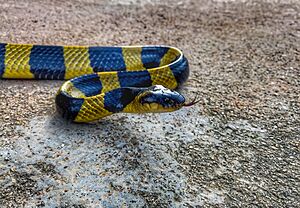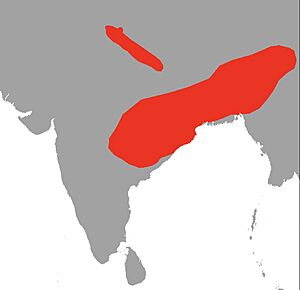Banded krait facts for kids
The banded krait (Bungarus fasciatus) is a very venomous snake found across Asia. You can find it from India all the way through Southeast Asia to Southern China. It's the longest krait, growing over 2 meters (6.5 feet) long. This snake has a unique pattern of gold and black bands.
Even though the banded krait is usually shy and calm, its venom is very strong. This venom, called neurotoxin, can be deadly to humans. While its venom might not be as strong as some other kraits, this snake produces a lot of venom because of its large size.
Quick facts for kids Banded krait |
|
|---|---|
 |
|
| Banded krait | |
| Conservation status | |
| Scientific classification | |
| Genus: |
Bungarus
|
| Species: |
fasciatus
|
 |
|
| Synonyms | |
|
|
Contents
What It Looks Like
The banded krait is easy to spot because of its black and yellow bands. These bands go all the way around its body. Its head is wide and flat, and it doesn't look very different from its neck. The snake has black eyes.
Its head is mostly black, but it has yellow markings that look like an arrowhead. Its lips, chin, and throat are also yellow. The tail is quite short, about one-tenth of the snake's total length.
The longest banded krait ever measured was 2.25 meters (7.4 feet) long. However, most banded kraits you might see are around 1.8 meters (5.9 feet) long.
Scales and Features
The banded krait has special scales. Along its back, it has a row of scales that are much larger than the others. These large scales are shaped like hexagons. The end of its tail is blunt. It also has a clear ridge running down its back.
The name of the snake's genus, Bungarus, comes from the Telugu word "bangarum." This word means "gold," which refers to the snake's yellow rings.
Where It Lives and Its Home
The banded krait lives across a large part of Asia. You can find it in countries like India, Nepal, Bangladesh, Myanmar, Thailand, Laos, Vietnam, Malaysia, and parts of China. It also lives on Indonesian islands like Borneo, Java, and Sumatra, and in Singapore.
In India, it is common in the eastern states like West Bengal and Assam. It becomes less common further west in India.
Preferred Places to Live
Banded kraits can live in many different places. They are found in forests and also in areas where people farm. They often live near water, in termite mounds, or in holes made by rodents. You might even find them close to villages. This is because villages often have rodents for them to eat and a good supply of water. They really like open, flat countryside areas. In Myanmar, banded kraits have been found living as high as 5,000 feet (1,500 meters) up in the mountains.
How It Behaves
Banded kraits are shy snakes and are not often seen. They are mostly active at night. If they feel bothered, they usually hide their heads under their coiled bodies. They generally don't try to bite during the day. However, at night, they are much more active and are considered more dangerous.
During the day, these snakes often rest in grass, ditches, or drains. They are slow and calm, even if someone tries to provoke them. You are most likely to see them during the rainy season.
What It Eats
The banded krait mainly eats other snakes. But it also eats fish, frogs, skinks (a type of lizard), and snake eggs. Some of the snakes it eats include:
- Sunbeam snake
- Rainbow water snake
- Red-tailed pipe snake
- Chequered keelback
- Buff-striped keelback
- Rat snake
- Indo-Chinese rat snake
- Cat snake
- Russell's viper
- Common krait
The banded krait swallows its prey headfirst after its venom has made the prey unable to move.
Reproduction
We don't know a lot about how banded kraits reproduce. In Myanmar, one female snake was found with eight eggs. Four of these eggs hatched in May. Baby banded kraits are about 298 to 311 millimeters (11.7 to 12.2 inches) long when they hatch. It's thought that these snakes become adults when they are about three years old and around 914 millimeters (3 feet) long.
Its Venom
The venom of the banded krait mostly contains special poisons called neurotoxins. These neurotoxins affect the nervous system. The amount of venom a banded krait delivers in a bite is usually between 20 and 114 milligrams.
If a person is bitten, the main effects of the venom can include:
- Vomiting
- Stomach pain
- Diarrhea
- Dizziness
A very serious bite can lead to problems with breathing. In some cases, a person might stop breathing and die. Banded krait venom can also harm the kidneys.
While its venom is powerful, bites are not always fatal. This is partly because the snake rarely bites humans, and when it does, it often doesn't inject much venom if it's just defending itself. Luckily, there are special medicines called polyvalent antivenoms available in places like India and Indonesia to treat bites.
Common Names
- Manipuri language – linkhak
- Mizo language – chawnglei, tiangsir
- Kannada – kattige haavu (ಕಟ್ಟಿಗೆ ಹಾವು)
- Karbi language – maipam, rui-teron
- Assamese language – xokha (শখা), xongkhosur (শংখচোৰ), gowala (গোৱালা), bandphora
- Bengali – shankhini (শঙ্খিনী), shankhamooti shaanp (শাঁখামুঠি) and rajsap (king snake) in Birbhum District কুসাপা (রাজবংশি ভাষায়)
- Burmese – ငန်းတော်ကျား ngān taw kyā
- Hindi – ahiraaj saamp
- Indonesian – welang
- Malayalam – manjavarayan (മഞ്ഞവരയൻ)
- Marathi – patteri manyar, पट्टेरी मण्यार agya manyar, sataranjya
- Odia – rana (ରଣା)
- Tamil – kattu viriyan (கட்டுவிரியன்), yennai viriyan, yettadi viriyan
- Telugu – katla paamu (కట్ల పాము) or bangaru paamu (బಂಗಾರು పాము) meaning the golden snake
- Tulu – kadambale
- Thai – ngu sam liam, งูสามเหลี่ยม, meaning the triangular snake
- Vietnamese – rắn cạp nong
- Nepali – नेपाली – गनगलि, गनग्वली, राजा साप वा सर्प gangali, gan gwali and Rajasaap (king of snakes) in Nepal
- Maithili – मैथिली – गन गुआर
Gallery




